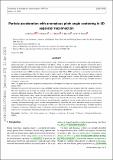Files in this item
Particle acceleration with anomalous pitch angle scattering in 3D separator reconnection
Item metadata
| dc.contributor.author | Borissov, Alexei | |
| dc.contributor.author | Neukirch, Thomas | |
| dc.contributor.author | Kontar, Eduard | |
| dc.contributor.author | Threlfall, James | |
| dc.contributor.author | Parnell, Clare | |
| dc.date.accessioned | 2020-01-28T17:30:01Z | |
| dc.date.available | 2020-01-28T17:30:01Z | |
| dc.date.issued | 2020-03 | |
| dc.identifier | 265915668 | |
| dc.identifier | 9f94e873-3e2b-4e88-9e0d-2607652aefd2 | |
| dc.identifier | 000520102800005 | |
| dc.identifier | 85088296469 | |
| dc.identifier.citation | Borissov , A , Neukirch , T , Kontar , E , Threlfall , J & Parnell , C 2020 , ' Particle acceleration with anomalous pitch angle scattering in 3D separator reconnection ' , Astronomy & Astrophysics , vol. 635 , A63 . https://doi.org/10.1051/0004-6361/201936977 | en |
| dc.identifier.issn | 0004-6361 | |
| dc.identifier.other | ArXiv: http://arxiv.org/abs/2001.07548v1 | |
| dc.identifier.other | ORCID: /0000-0002-7597-4980/work/71221410 | |
| dc.identifier.other | ORCID: /0000-0002-5694-9069/work/73700734 | |
| dc.identifier.uri | https://hdl.handle.net/10023/19366 | |
| dc.description | A.B. would like to thank the University of St Andrews for financial support from the 7th Century Scholarship and the Scottish Government for support from the Saltire Scholarship. T.N., J.T. and C.E.P. gratefully acknowledge the support of the UK STFC (consolidated grants SN/N000609/1 and ST/S000402/1). E.P.K. acknowledges the financial support from the STFC consolidated grant ST/P000533/1. | en |
| dc.description.abstract | Context. Understanding how the release of stored magnetic energy contributes to the generation of non-thermal high energy particles during solar flares is an important open problem in solar physics. There is a general consensus that magnetic reconnection plays a fundamental role in the energy release and conversion processes taking place during flares. A common approach for investigating how reconnection contributes to particle acceleration is to use test particle calculations in electromagnetic fields derived from numerical magnetohydrodynamic (MHD) simulations of reconnecting magnetic fields. These MHD simulations use anomalous resistivities that are orders of magnitude larger than the Spitzer resistivity that is based on Coulomb collisions. The processes leading to such an enhanced resistivity should also affect the test particles, for example, through pitch angle scattering. This study explores the effect of such a link between the level of resistivity and its impact on particle orbits and builds on a previous study using a 2D MHD simulation of magnetic reconnection. Aims. This paper aims to extend the previous investigation to a 3D magnetic reconnection configuration and to study the effect on test particle orbits.Methods. We carried out orbit calculations using a 3D MHD simulation of reconnection in a magnetic field with a magnetic separator. The orbit calculations use the relativistic guiding centre approximation but, crucially, they also include pitch angle scattering using stochastic differential equations. The effects of varying the resistivity and the models for pitch angle scattering on particle orbit trajectories, final positions, energy spectra, final pitch angle distribution, and orbit duration are all studied in detail. Results. Pitch angle scattering widens highly collimated beams of unscattered orbit trajectories, allowing orbits to access previously unaccessible field lines; this causes final positions to spread along other topological structures which could not be accessed without scattering. Scattered orbit energy spectra are found to be predominantly affected by the level of anomalous resistivity, with the pitch angle scattering model only playing a role in specific, isolated cases. This is in contrast to the study involving a 2D MHD simulation of magnetic reconnection, where pitch angle scattering had a more noticeable effect on the energy spectra. Pitch scattering effects are found to play a crucial role in determining the pitch angle and orbit duration distributions. | |
| dc.format.extent | 15 | |
| dc.format.extent | 3378813 | |
| dc.language.iso | eng | |
| dc.relation.ispartof | Astronomy & Astrophysics | en |
| dc.subject | Sun: flares | en |
| dc.subject | Sun: X-rays, gamma rays | en |
| dc.subject | magnetic reconnection | en |
| dc.subject | Scattering | en |
| dc.subject | Turbulence | en |
| dc.subject | Magnetohydrodynamics (MHD) | en |
| dc.subject | QB Astronomy | en |
| dc.subject | QC Physics | en |
| dc.subject | T-NDAS | en |
| dc.subject.lcc | QB | en |
| dc.subject.lcc | QC | en |
| dc.title | Particle acceleration with anomalous pitch angle scattering in 3D separator reconnection | en |
| dc.type | Journal article | en |
| dc.contributor.sponsor | Science & Technology Facilities Council | en |
| dc.contributor.sponsor | Science & Technology Facilities Council | en |
| dc.contributor.institution | University of St Andrews. Applied Mathematics | en |
| dc.identifier.doi | https://doi.org/10.1051/0004-6361/201936977 | |
| dc.description.status | Peer reviewed | en |
| dc.identifier.url | https://arxiv.org/abs/2001.07548 | en |
| dc.identifier.grantnumber | ST/S000402/1 | en |
| dc.identifier.grantnumber | ST/N000609/1 | en |
This item appears in the following Collection(s)
Items in the St Andrews Research Repository are protected by copyright, with all rights reserved, unless otherwise indicated.

